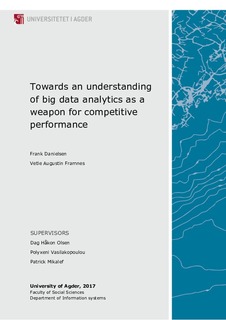| dc.contributor.author | Danielsen, Frank | |
| dc.contributor.author | Framnes, Vetle Augustin | |
| dc.date.accessioned | 2017-09-19T10:53:51Z | |
| dc.date.available | 2017-09-19T10:53:51Z | |
| dc.date.issued | 2017 | |
| dc.identifier.uri | http://hdl.handle.net/11250/2455412 | |
| dc.description | Master's thesis Information Systems IS501 - University of Agder 2017 | nb_NO |
| dc.description.abstract | Context: Big data has in the recent years been an area of interest among innovative organizations and has started to become a major priority for organizations in general, either through their own big data departments or by purchasing big data analyses from suppliers. Big data analytics means more knowledge from more data sources and is by many prophesied to be a contributing source of big change in how organizations receive their intelligence.
Purpose: This thesis investigates the connection between big data and competitive performance. This connection could be explained through the following two paths; 1) how big data analytics contribute to making an organization more agile/dynamic and 2) how big data analytics improves daily operations. To measure this, we looked at big data analytics capabilities, dynamic capabilities and operational capabilities in addition to competitive performance.
Methods: The methods that were used in this research was mainly of a quantitative type in addition to a qualitative case study and a two-phased literature review. We had to establish how to define and measure big data analytics capabilities. To do this we had to collect and review existing literature on big data analytical capabilities. We then had to do the same process with dynamic capabilities, operational capabilities and competitive performance. Even if there were little to no examples of previous literature on the whole scope of our research area, there were jigsaw bits that contained important knowledge on the different parts of the research area. With the help of previous literature and our case study, a survey was created. This was sent to big organizations in Nordic countries, mainly from the Kapital 500 list of the biggest organizations in Norway and Forbes Global 2000 list, where we focused on the biggest organizations in the Nordic countries. Extensive work was put into sorting away organizations that did not use big data, and to get respondents that did. A total of 135 respondents completed the survey and 107 of those used big data solutions. We developed a model with four hypotheses to investigate the relationship between big data analytic capabilities and competitive performance through the mediating concept of dynamic capabilities and operational capabilities. We analysed the responses using structural equation modelling. Specifically, we used partial least square path modelling (PLS-SEM). The tool used to distribute the survey was SurveyGizmo and we used SmartPLS to analyse the data.
Results: Our analyses validated our first hypothesis which points to the positive correlation between big data analytics capabilities and dynamic capabilities to be significant. Further, the second hypothesis that stipulates the path from dynamic capabilities to competitive performance was significant. We also found significance on our third hypothesis which suggest a positive correlation between big data analytics capabilities and operational capabilities. We failed to find any significance on the fourth hypothesis which proposed that there is a positive correlation between operational capabilities and competitive performance. Also, we did not
VI
find any significance on environmental factors moderating effect on the second and fourth hypothesis.
Conclusion:
Overall, our results shows that the concept of big data analytics capability is transformed into competitive performance through the path of dynamic capability which can be seen as a mediating factor. This study contributes to better understand how big data analytics investments are turned into competitive actions and will be particularly valuable for companies using big data.
Key words: big data analytics; big data analytics capabilities; dynamic capabilities; operational capabilities; competitive performance | nb_NO |
| dc.language.iso | eng | nb_NO |
| dc.publisher | Universitetet i Agder ; University of Agder | nb_NO |
| dc.rights | Attribution-NonCommercial-NoDerivatives 4.0 Internasjonal | * |
| dc.rights.uri | http://creativecommons.org/licenses/by-nc-nd/4.0/deed.no | * |
| dc.subject | IS501 | nb_NO |
| dc.subject | big data analytics | nb_NO |
| dc.subject | big data analytics capabilities | nb_NO |
| dc.subject | dynamic capabilities | nb_NO |
| dc.subject | operational capabilities | nb_NO |
| dc.subject | competitive performance | nb_NO |
| dc.title | Towards an understanding of big data analytics as a weapon for competitive performance | nb_NO |
| dc.type | Master thesis | nb_NO |
| dc.subject.nsi | VDP::Samfunnsvitenskap: 200::Statsvitenskap og organisasjonsteori: 240 | nb_NO |
| dc.source.pagenumber | X, 98 p. | nb_NO |

